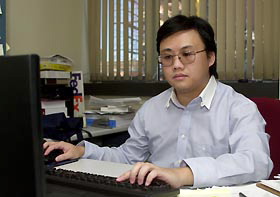|
This is an archived article.
For the latest news, go to the Advance
Homepage
For more archives, go to the Advance Archive/Search Page. | ||
|
Engineer's Research Helping to
Change How Military Operates
In 1997, he accepted a position with UConn's School of Engineering, where he has expanded his research in artificial intelligence. As a researcher trained in cognitive science, Santos tries to better understand how the brain's thought processes work and that becomes the basis for the computer software he develops. The vast majority of his funding has come from the Air Force, including support for two current projects: developing software for an advanced logistics system and an adversarial intent program. It is the latter project that suddenly is in the military's cross hairs. "Since the terrorist attacks on September 11, the linear, large-scale military operations like the Persian Gulf War are a thing of the past," says Santos. "The military is reconfiguring itself to better respond to the asymmetrical tactics used by terrorists." Asymmetrical warfare is defined by the Department of Defense as countering an adversary's strengths by focusing on its weaknesses. In the first weeks of the war in Afghanistan, the U.S. used its air power and targeting technology and avoided the Taliban's ground defenses. Now that the face of war has changed, Santos says the push by the Air Force is to determine enemy intent - a bull's eye for the UConn researcher. Still in the early stages of development, Santos' adversarial intent program is designed to predict enemy behavior and actions, as well as explain them, by using Bayesian Networks - probabilistic computer models of causality. The young scientist plans to accomplish this by using mobile and multi-agent systems to gather information about the enemy and learn from their actions. The approach is a shift from the current U.S. military doctrine of objectives-based operations to those that are effects-based, with the goal of influencing enemy actions by carefully choosing our actions. Changing the way the military operates does not end there. As part of the second project funded by the Air Force, Santos hopes to redefine the way the military positions people and equipment, to ensure they are in the right places at the right time. Now in its third year, the joint project involves fellow UConn engineers Steven Demurjian and Alex Shvartsman, along with researchers at Wright State and Kansas State universities. Santos draws on his experience working at the Air Force Institute of Technology during Desert Storm, when he heard stories about logistical failures. "They pre-positioned assets in a way that turned out to be inefficient and redundant," he explains. "We were successful in that war because our commanders are trained to be independent - to use initiative, so they were able to make substitutions. I want to make it easier on them by giving them a tool that will help find the resources they can't see or identify right away." Think of it as creating a virtual Corporal Klinger or Radar O'Reilly from the television show, MASH. Those characters could locate and requisition just about anything for their unit, from Grade A steak to a fleet of armored tanks. What Santos envisions is a hand-held device that commanders would have at the ready and be able, with a series of key strokes, to receive critical information in a timely manner. The research team is conducting its final tests on the advanced logistics system prototype and will turn over the research to the military within the year. Janice Palmer |
 uring the past month, Eugene Santos has barely had enough
time to unpack his suitcase before heading to another brainstorming
session. The associate professor of computer science and
engineering has been summoned to four workshops in as many weeks,
and juggling that with his teaching and research responsibilities
is no easy feat. But when the U.S. Air Force calls during a time of
national crisis, you do not turn them down.
uring the past month, Eugene Santos has barely had enough
time to unpack his suitcase before heading to another brainstorming
session. The associate professor of computer science and
engineering has been summoned to four workshops in as many weeks,
and juggling that with his teaching and research responsibilities
is no easy feat. But when the U.S. Air Force calls during a time of
national crisis, you do not turn them down.
